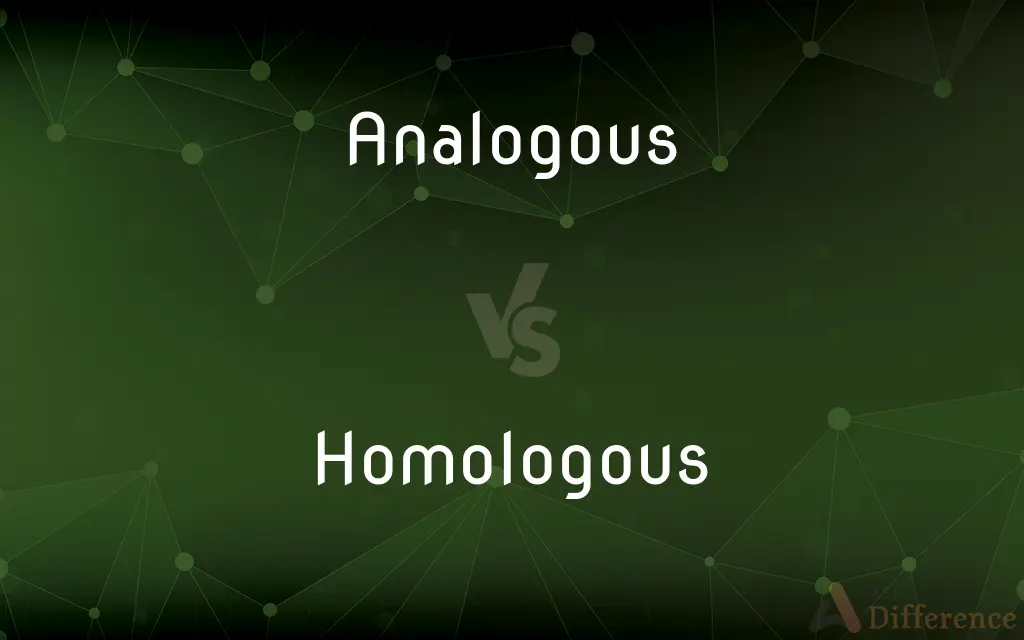Analogous vs. Homologous — What's the Difference?
By Urooj Arif & Fiza Rafique — Updated on April 25, 2024
Analogous structures perform similar functions but arise from different evolutionary origins, while homologous structures share a common ancestry but may serve different functions.

Difference Between Analogous and Homologous
Table of Contents
ADVERTISEMENT
Key Differences
Analogous structures, found in different species, are adaptations to similar environmental challenges and thus perform similar functions, even though these species are not closely related. Whereas homologous structures stem from a common ancestral trait that has diverged over time, adapting to different uses or environments in related species. For example, the wings of a butterfly and a bird are analogous because they both serve the purpose of flight, yet they evolved independently from different ancestors.
In terms of evolutionary biology, analogous features underline the concept of convergent evolution, where different organisms develop similar traits independently, often because they inhabit similar environments. On the other hand, homologous features highlight divergent evolution, where traits evolve in different directions from a common point, reflecting different ecological roles or adaptations.
Morphologically, analogous structures can vary widely in their basic anatomy and genetic origin, demonstrating the creative ways in which life adapts to similar challenges. In contrast, homologous structures share a more uniform anatomical heritage and are often similar in basic structural plan, even if their outward forms and functions have diverged significantly.
Developmentally, analogous structures often arise from entirely different tissues or developmental pathways in different organisms. Whereas homologous structures typically originate from the same embryonic tissues in organisms that share a common ancestor, underlining their shared evolutionary backgrounds.
The study of analogous and homologous structures provides significant insights into evolutionary processes. Biologists use homology to construct phylogenetic trees and explore evolutionary relationships, whereas analogy can be misleading in phylogenetics but is crucial for understanding how organisms adapt to their environments through natural selection.
ADVERTISEMENT
Comparison Chart
Definition
Structures with similar functions but different evolutionary origins.
Structures derived from a common ancestor that may have different functions.
Evolutionary Process
Result from convergent evolution.
Result from divergent evolution.
Morphology
Differ fundamentally in basic structure; adapted to similar functions.
Similar in basic structure; adapted to different functions over time.
Developmental Origin
Arise from different tissues or developmental pathways.
Originate from the same embryonic tissues.
Significance in Biology
Illustrate adaptation to similar environmental pressures.
Indicate phylogenetic relationships among species.
Compare with Definitions
Analogous
Resulting from convergent evolution.
The succulent leaves of cacti and some euphorbias are analogous.
Homologous
Pertaining to structures that have a common evolutionary origin despite possibly having different functions.
The forelimbs of humans and bats are homologous.
Analogous
Showing similarity in function and superficial resemblance but differing in origin.
The fins of fish and flippers of whales are analogous.
Homologous
Resulting from divergent evolution.
The beaks of various species of finches are homologous.
Analogous
Characterizing features in different species that have evolved independently.
The eye structures of cephalopods and vertebrates are analogous.
Homologous
Descending from the same part of a common ancestor.
The bones in a bird's wing are homologous to those in a human arm.
Analogous
Relating to structures that perform similar functions but are not derived from a common ancestor.
The wings of birds and insects are analogous.
Homologous
Characterized by being similar in position and developmental origin.
The leaves of a maple and the leaves of an oak are homologous.
Analogous
Developed as a response to similar environmental challenges despite different ancestries.
The streamlined bodies of sharks and dolphins are analogous.
Homologous
Indicating phylogenetic relationships among species.
The vertebrate skeletal structure is homologous.
Analogous
Similar or alike in such a way as to permit the drawing of an analogy.
Homologous
Corresponding or similar in position, value, structure, or function.
Analogous
(Biology) Similar in function but not in structure and evolutionary origin.
Homologous
Derived from the same species
A homologous graft.
Analogous
Having analogy; corresponding to something else; bearing some resemblance or proportion (often followed by "to".)
Homologous
(Biology) Similar in structure and evolutionary origin, though not necessarily in function, as the flippers of a seal and the hands of a human.
Analogous
(biology) Functionally similar, but arising through convergent evolution rather than being homologous.
Homologous
(Immunology) Relating to the correspondence between an antigen and the antibody produced in response to it.
Analogous
Having analogy; corresponding to something else; bearing some resemblance or proportion; - often followed by to.
Analogous tendencies in arts and manners.
Decay of public spirit, which may be considered analogous to natural death.
Homologous
Relating to chromosomes that have the same morphology and linear sequence of gene loci.
Analogous
Similar or correspondent in some respects though otherwise dissimilar;
Brains and computers are often considered analogous
Surimi is marketed as analogous to crabmeat
Homologous
Relating to genes that are derived from a common ancestor.
Analogous
Corresponding in function but not in evolutionary origin;
The wings of a bee and those of a hummingbird are analogous
The wing of a bat and the arm of a man are homologous
Homologous
(Chemistry) Belonging to or being a series of organic compounds, each successive member of which differs from the preceding member by a constant increment, especially by an added CH2 group.
Homologous
Showing a degree of correspondence or similarity.
Homologous
(mathematics) In corresponding proportion.
Homologous
(biology) Corresponding to a similar structure in another life form with a common evolutionary origin.
Flippers and hands are homologous structures.
Homologous
(chemistry) Belonging to a series of aliphatic organic compounds that differ only by the addition of a CH₂ group.
Homologous
(genetics) Having the same morphology as another chromosome or locus; relating to a homologue.
Homologous
Playing the same role as seen in another culture, whether by historical connection, psychological archetype, convergent cultural evolution, or otherwise (as may be hypothesized but not known with certainty by current science), as for example with the cryptozoologic concepts of yeti and sasquatch, the use of polite and familiar pronouns, or other similarities.
Homologous
Having the same relative position, proportion, value, or structure.
In similar polygons, the corresponding sides, angles, diagonals, etc., are homologous.
Homologous
Having the same relative proportion or value, as the two antecedents or the two consequents of a proportion.
Homologous
Having the same evolutionary origin but serving different functions;
The wing of a bat and the arm of a man are homologous
Homologous
Corresponding or similar in position or structure or function or characteristics; especially derived from an organism of the same species;
A homologous tissue graft
A heterologous graft
Common Curiosities
How do biologists use analogous structures to study evolution?
Biologists study analogous structures to understand how different organisms adapt to similar environmental pressures through convergent evolution.
What is an example of a homologous structure that has adapted to different functions?
The flippers of whales and the hands of humans are homologous structures; both derive from the forelimbs of a common tetrapod ancestor but have adapted to very different functions.
How do homologous structures help in constructing phylogenetic trees?
Homologous structures provide insights into the evolutionary relationships among species, helping biologists trace lineage divergences and construct phylogenetic trees.
Why are analogous structures not useful in determining phylogenetic relationships?
Because analogous structures arise independently in response to similar environmental challenges, they do not indicate a direct evolutionary relationship between the species that possess them.
What is a real-world application of understanding homologous structures?
Understanding homologous structures helps in fields like comparative anatomy, genetics, and evolutionary biology, enhancing our knowledge of how species evolve and relate to each other.
Is the human hand more analogous or homologous to the monkey hand?
The human hand is homologous to the monkey hand, as both evolved from the forelimbs of a common primate ancestor and share a similar skeletal structure.
What role does the environment play in the development of analogous structures?
Environmental pressures like climate, geographical isolation, and available resources can drive the independent evolution of analogous structures in different species.
How can one distinguish between homologous and analogous structures?
One can distinguish them by studying the developmental origin and basic anatomical structure; homologous structures share embryonic origins and structural similarities, whereas analogous structures do not.
How do analogous structures impact the survival and competitiveness of species?
Analogous structures can greatly enhance the survival and competitiveness of species by allowing them to adapt to similar niches or environmental challenges in different geographical locations.
What implications do homologous structures have for genetic research?
Homologous structures suggest a common genetic basis among different species, which is crucial for genetic research, including studies on gene function and regulation.
Why might a biologist study both homologous and analogous structures?
Studying both types of structures provides a comprehensive understanding of evolutionary processes, illustrating both shared ancestry and adaptive evolution.
What can the study of analogous structures tell us about natural selection?
The study of analogous structures highlights the role of natural selection in shaping similar adaptations in unrelated organisms facing similar environmental pressures.
How do homologous structures differ between closely related species?
In closely related species, homologous structures often exhibit slight variations that reflect adaptation to different environmental or ecological niches within a shared evolutionary framework.
Can analogous structures arise in plants as well as animals?
Yes, analogous structures can arise in plants; for example, the wings of a maple seed and the wings of a pine seed are analogous structures that evolved independently to perform the same function of seed dispersal.
How do environmental changes influence the evolution of homologous structures?
Environmental changes can drive the diversification of homologous structures into new forms and functions, as species adapt to new challenges or opportunities.
Share Your Discovery

Previous Comparison
Toilet vs. Latrine
Next Comparison
Barley vs. RyeAuthor Spotlight
Written by
Urooj ArifUrooj is a skilled content writer at Ask Difference, known for her exceptional ability to simplify complex topics into engaging and informative content. With a passion for research and a flair for clear, concise writing, she consistently delivers articles that resonate with our diverse audience.
Co-written by
Fiza RafiqueFiza Rafique is a skilled content writer at AskDifference.com, where she meticulously refines and enhances written pieces. Drawing from her vast editorial expertise, Fiza ensures clarity, accuracy, and precision in every article. Passionate about language, she continually seeks to elevate the quality of content for readers worldwide.













































